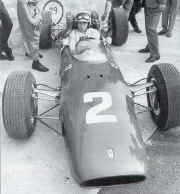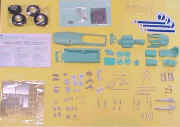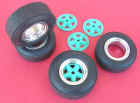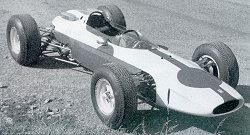|
I made my first review of a kit a few years ago, and I remember that I said that reviewing a kit was something more than a simple description of all the parts that you look at when you open a box; you have to "transmit" a sensation and "project" and opinion, as a logical conclusion.
I think that those ideas are more valid in this review.
In order to fulfill the task of making a complete review of a kit as complex as this ABC Brianza's Ferrari 158 in 1/12 scale, maybe we will need a little explanation on how complicated it is to manufacture a kit, whose main parts are resin and white metal.
When a manufacturer begins a project to produce a new kit, he must follow various stages, tasks, and requisites that take several months, as well as a great deal of money, in order to pay the artisans and technicians involved in the project. The task of making a whole new kit is something that cannot be done in a day, it takes a lot of hard working hours of not only one, but several people involved.
The first stage is the making of the "master moulds", either by hand or with the aid of a computer, and then the manufacturer must produce the "final moulds" which will be used in the production of the kits that you will acquire and enjoy.
|
This stage is crucial and the costs involved may get to several thousands, or even more than a hundred thousand dollars. So, a manufacturer must take the decision to make "rubber molds" for resin, or steel molds which will be used in a high pressure plastic injection machine.
The cost for a 1/12 steel "master" is so expensive nowadays, that even giant manufacturers like Tamiya don't do them...and they probably won't for a long time. However, there are some "artisans", like Brianza, that take the decision to make rubber molds and resin kits, as a way to lower the costs and make a kit feasible.
So, in order to be fair, we should "judge" the quality of the molds and the parts that we receive when we buy the kit, separately.
|

|
|
Monza '64, photo from the book "50 years of Ferrari"
|
|
The kit
The kit from ABC represents the car that Ferrari campaigned for the 1964 F1 championship, and we must say that ABC has captured the real "essence" of this car, and you don't have to use your imagination in order to figure out the 158 from the parts included in the kit box.
|

|
I always wanted to build a model of this car because 1964 was the beginning of my "career" as an F1 fan. I remember that my father used to buy an Argentinian car magazine titled AUTOMUNDO. My memory is not very precise, but I remember that I was surprised when Ferrari switched to a 12 cylinder engine for the 1965 season.
The ABC is a multimedia kit and it is quite surprising in some aspects, while a little bit disappointing in others.
My first impression was that of a very well thought and completed kit. I must say that this is a model that shows its inner parts, that is, it is not a "curbside" model; all the inner parts have been reproduced, maybe there are some details missing, we would have to check with pictures of the real car, but all the basics are there. I must say that it has about the same details and parts as in a plastic kit.
The body parts are as extremely thin, even thinner than Tamiya's Ferrari 312B!!!; this is an absolute achievement considering that the parts are full resin. Moreover, the parts are separated exactly like in the real car.
|
One of the that impressed me was the monocoque, a resin part with an enormous photoetched which has all the rivets like in the real car.
It called my curiosity that this is the same technique used by a fellow modeler and friend from Argentina, Fernando Benedetto, to build the MG's Ferrari 312P, he sanded the side resin pontoons in order to thin the part enough to add an aluminum part with all the rivets engraved on it
Because of its fragility I'm aware that maybe it will quite difficult to work with this part, but my experience "tells" me that the final result will be really surprising.
|

|

|

|
|
There are some contrasts in this kit, like the chrome rear view mirrors which have a high quality, the engine, with all the details faithfully reproduced, and the not so good white metal rear suspension uprights.
|

|
|
Metal parts are cleanly "cast" and, generally speaking, with good quality, except for the above mentioned parts. I was impressed by some of the parts like the rack and pinion steering, and the chromed gearshift knob; I must say that all these parts are remarkable.
|

|
|
The velocity stacks are made out of polished aluminum, and they are punched like in the real car.
|

|
|
The strongest point in the kit, and one that is vital for the "looks" of an F1 racer, is the wheels. They are absolutely superb, turned and polished aluminum rims with an excellent center piece made of resin and a PE parts for the wheel lugs.
Tires are rubber...with a quality similar to that in a Tamiya kit, the tread is very accurate although the sidewall detail is missing.
|

|

|
There are other very good quality details like the PE instrument panel, although the instrument faces are decals, and some other parts for the engine and the monocoque. Water radiator is resin with PE parts, the windshield is vacuumed clear plastic, there is only one in the kit, I think that it would be a good idea to put a spare one "just in case".
All of the above details are the kit's strong point, but there is a weak point too, its not with the model but with the instructions manual, it lacks a lot of information. The first page shows a list a description of parts, as well as the colors to paint them. There are two more pages with a picture of the engine, good but not enough, and a very good slide...with half of it missing!
There are three more pages with "brief" building instructions and very simple drawings, without any comments to help you in the building process.
There are three small decal sheets of good quality.
The price is the average for these kind of models although, as a modeler, I would like it to be a little lower; but I understand that due to the somehow reduced production of these kits, and the fact that the molds must be changed quite often, the price is reasonable.
In the accompanying pictures, you can appreciate some parts of this incredible kit.
Brianza offers three versions. The here shown belongs to 1964 Nurburgring GP, which John Surtees won it with.
Conclusion
I've spent almost an hour thinking about the conclusion and personal opinion about this kit, what would had happened if this kit were in plastic, no doubt that we would be in the presence of one of the most interesting "old model" available in 1/12 scale. However, I must go to the beginning of this note, this is not possible for ABC and, apparently, not even for Tamiya. So, we must admit that this is a great kit, with all the restrictions inherent to a resin cast multimedia model.
Unfortunately, ABC failed in the easiest part, the instruction manual. We must keep in mind that there are kits with not too good quality, like Protar, but with a good instruction manual full of details, although the plastic parts do not allow you to achieve the detail level shown in the illustrations, because of their low quality.
Here we have a different situation; if you are an experienced F1 model builder, you could assemble this model without the manual, and it would be a great model to add to your collection; in fact, all the collectors I know have already bought this kit
If you are a newcomer to resin models, it would be very convenient for you to start with a less complicated model where you could get more experience on how to handle multimedia kits, and then try to get the most information about this car (pictures, etc.), before starting with the building of the kit.
My final opinion, no doubt that this is a great kit with very well detailed parts, good proportions, and an excellent final appearance. The resin parts are equal to any good resin kit; with all the "standard" preparation procedures normal with this kind of materials.
I don't want to finish this note without expressing a personal idea for you to think about. If you like 1/12 scale models, I'm sure that you want to see more of them in the future, and it is more than probable that you will not get them from the big plastic manufacturers; so we must encourage small and medium manufacturers to keep offering models like this, each time with better details, but with the normal inconsistencies of these materials.
|
Ferrari 158 with NART colours (North American Racing Team), white and light blue
ABC kit ref # 1206A, Mexico GP.
|

|
|